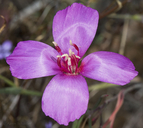notes I gently flexed back the petals of the Clarkia rubicunda flowers in this series in order to provide a better view of the stamens and style. (I returned them to their normal position afterwards, so as not to interfere with subsequent pollination and other developments.) Most species of Clarkia are protandrous, meaning the anthers mature and release their pollen before the stigmas mature. The 5 images in this series illustrate various stages in the developmental sequence of flowering in C. rubicunda.
In the first 4 images, the valves of the red anthers are in various stages of dehiscense (i.e. opening and shedding their pollen), while the rose-lavender colored style remains closed and can be seen leaning to the side (near the petal on the left in 1st, 2nd and 4th images). In the 5th image, the anthers have shed nearly all their pollen and the style is erect...with its 4 receptive (papillate) stigma lobes outspread in the characteristic ''cross'' shape of the genus Clarkia.
Note that the stamens are grouped in two alternating sets of 4: those opposite the petal bases have shorter filaments, and dehisce before those opposite the sepal bases...the later having longer filaments. The inner set of stamens, opposite the petals, curve inward over the opening of the flower tube as they dehisce...so that a visiting pollinator is likely to contact them and pick up pollen when attempting to reach nectaries in the floral tube at the base of the corolla. The stigma, when it becomes receptive, also moves towards the center of the flower...so that visitors seeking nectar from the tube will make contact with the receptive stigma lobes (hopefully, pollinators that recently picked up pollen from a nearby flower of another plant that was still in the earlier ''male phase'' of flowering, with anthers still dehiscing and releasing copious amounts of pollen).
The lighter-colored lavender style is leaning against the petal on the left. While the stamens are attached to the upper rim of the flower tube, the style is attached to the top of the ovary...much further below at the bottom of the tube. The stigma lobes here are still unopened and fused into the 4-grooved linear tip on the style.
Later, when the stigmas are receptive, pollen landing there will attempt to grow a ''pollen tube'' down the style to reach the ovules in the ovary and deliver sperm cells to fertilize the ovules. The pollen tube growth is facilitated (or inhibited) by cells within the stigma/style, depending on various factors.
